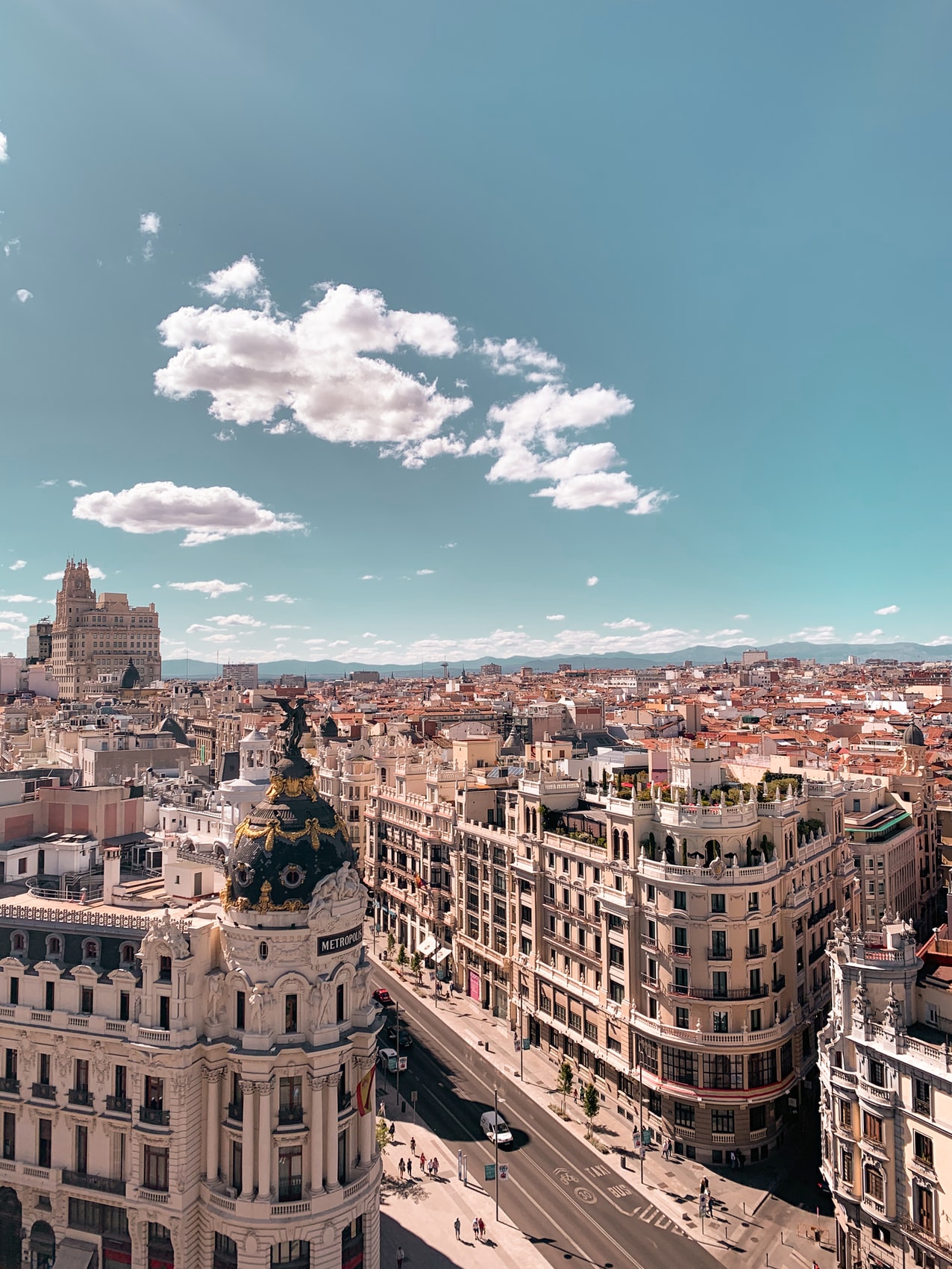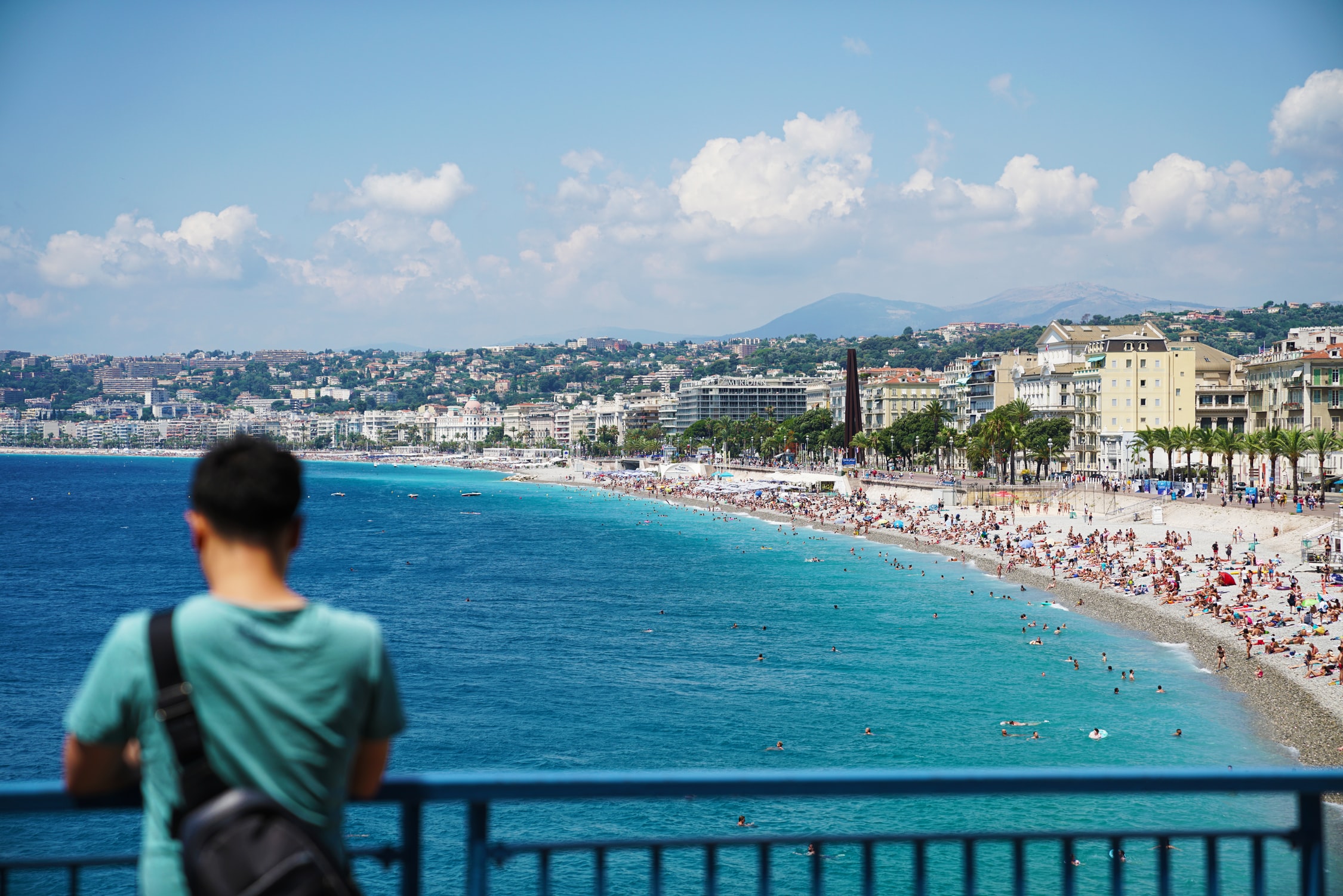Interrail in Spain: the ultimate country guide 🇪🇸
- Delicious food
- Grand architecture
- Warm weather
- Beautiful beaches
Beautiful beaches
Delicious food
Grand architecture
Warm weather
Fabulous wine
Table of contents 🇪🇸
Spain overview
- Population: 46.6 million
- Capital: Madrid
- Language: Spanish
- Currency: Euro
- Dialling code: +34
Spain is a colourful and passionate country of diverse cultures, stunning geography and relaxed people. It is the land of the siesta, local traditions, culture and gastronomy where daily life moves slowly and often runs late. With breathtaking cities, endless cultural festivals, world-class beaches, and renowned nightlife, Spain is impressive all year long.
Madrid and Barcelona are hip, energetic and lively, the colourful Granada has a typical Moorish touch, while Basque Country up north contrasts itself to Southern living. The Spaniards are hospitable, love good wine, a good meal, laughter and enjoy life. Part of it is sangria, as well as paella and tapas.
Spain is a very inexpensive country to visit. Interrailers often head to Madrid and are impressed by the capital city, home to the Royal Palace and Prado museum, housing works by European masters. The most popular spot for Interrail travellers is Catalonia’s capital, Barcelona, defined by Antoni Gaudí’s whimsical modernist architecture – like the Sagrada Família church. Spain has 47 UNESCO World Heritage Sites, which makes Spain the 3rd ranked country in the world for the most UNESCO World Heritage Sites. The Spanish heritage includes pre-historic art, historic cities and buildings, bridges, national parks and landscapes.
The top 5 cities to visit in Spain
Madrid
In Madrid, life begins at midnight. It’s a city that has an amazing fusion of history and modern, urban lifestyle, rooftop bars, great nightlife, fantastic museum exhibitions, and luscious green parks. Even though it is often (unfairly) overshadowed by Barcelona, Madrid is a vibrant city with delicious food, affordable living, and premium shopping. Madrid also has one of the best public transit systems in the world.
Madrid is home to The Prado, one of the largest museums in the world, which has one of the world’s finest collections of European art, dating from the 12th century to the early 20th century, including Titian, Goya, Rubens. Visit the Royal Palace, as well as the main square, Plaza Mayor.
Top local Spanish foods to try are bacalao (salted and dried cod), olive oil and olives, jamon (ham), cheese, patatas bravas (smoky potatoes fried in oil with aioli), and pimientos de padrón (spicy fried peppers). A beloved location is the famous and historic café at Pasadizo de San Gines, which specialises in thick hot chocolate and deep-fried churros.


Barcelona
One of the most attractive cities in Europe, Barcelona enjoys its role as the capital of Catalonia. The city’s cosmopolitan international vibe makes it a popular destination for many people, and is renowned for its unique architecture and art. Travellers are attracted by the iconic Sagrada Família church, La Rambla boulevard and other modernist sites designed by Antoni Gaudí, such as Parc Guell, Casa Mila and Casa Batilo. Situated on the beach, you can take a break from sightseeing and have a dip in the Mediterranean while you relax with a cold sangria, or cerveza!
Barcelona is famous for its partying, late-night eating and historic streets, so learn to sleep until 10pm and eat dinner at midnight in the streets of Barcelona just like the locals do.
There is also the wonderful Picasso Museum and the educational and interactive History Museum in Barcelona, which is one of the best in Europe.
If you like football head to the Camp Nou and go on a stadium tour, or catch a game if you’re lucky enough to be in town when a game is on!
If you’re on an Interrail trip in Spain, you simply have to check out Barcelona.
Seville
Seville is the artistic, cultural, and financial capital of southern Spain, a vibrant city full of architecture, history, and life. The cityscape is made up of famous churches, palaces, historic sites and winding streets.
Casa de Pilatos, built in 1500 AD, is the main sight in Seville. It also houses a collection of 16th and 19th century paintings, and across the palace the sculptures of Greek mythological figures. Fans of Moorish architecture will love Alcazar, a recognised UNESCO site, which also serves as a royal residence when the Spanish royal family visits Seville.
The Metrosol Parasol has become somewhat of a centerpiece in the city and you won’t miss it. It’s a wooden landmark, which was completed in 2011, and is a popular meeting spot in the summer months as it offers shade from the intense Sevillanos heat.
The Jewish Quarter, generally regarded as the most charming part of the city, is located around the old Cathedral and consists of small winding streets.
Seville is also a big university town, so there’s lots to be had in the way of nightlife and late night drinking. Eat authentic Spanish tapas and enjoy great flamenco dancers.


Valencia
It may be true that Spain’s third largest city lacks spectacular monuments like Madrid or Barcelona, but it makes up in countless charming alleyways, a lovely cathedral, a fantastic market, and most importantly, the authentic Spanish flair. The historic old town is the main spot for the major attractions: The Cathedral of Valencia (Catedral de Santa María de Valencia), with its mix of different architectural styles and Mercado Central (Central Market), which is a must when staying in Valencia.
The city’s vibrant neighbourhoods are full of cafes and restaurants and the streets are full of colour and creative street art.
Torre de Serranos is the former medieval city gate, a witness to the long past and importance of this city. However, the city is also proud of Ciutat de les Arts i les Ciències, the building complex “City of Arts and Sciences”, which is without a doubt, the most futuristic attraction of Valencia and a modern landmark worth seeing. The individual buildings house different museums, the most famous among them is L’Oceanogràfic.
Like Barcelona, Valencia benefits from being by the sea and you can take a break from the sightseeing at the beach by heading to one of the many bars by the marina.
Bilbao
Perched on the northern shores of Spain, Bilbao is an epic and upcoming city in the Basque Country. Bilbao has a gorgeous historic centre with The Casco Viejo or Old Town that comprises the medieval core of the city, but it is also very youthful, energetic and charming.
The Guggenheim Museum is not only one of the best things to do in Bilbao, but easily one of the most iconic buildings in Spain. The museum is not only home to one of the best modern art collections in Europe, the museum building itself is an extraordinary piece of art. The Tulips and the huge Puppy by Jeff Koons are some of the most photographed statues.
Just under an hour away from the centre of Bilbao is the beautiful coastline around San Juan de Gaztelugatxe with the stunning Bay of Biscay, which is definitely worth the trip. Gaztelugatxe was also a location for Dragonstone in Game of Thrones. It’s also worth making a trip to San Sebastian, renowned for being Spain’s capital of food, serving up some of the best seafood in the whole of Europe.

People who visit Spain also visit...
France 🇫🇷
Portugal 🇵🇹
Which Interrail pass do I need to travel around Spain?
Interrail Global Pass
Interrail Spain Pass
Do I need to make train seat reservations in Spain?
The train network in Spain is well developed and extensive, mostly operated by RENFE.
There are lots of high speed trains in Spain, for which you will need to book seat reservations. You need to make seat reservations on Avant (AVN), AVE, Alvia (IC), Intercity (IC), and Euromed (EUR) domestic trains. You won’t usually require a seat reservation for domestic Media Distancia (RE) and Cercanías (RE) trains.
To travel to both France and Portugal, you will need to make seat reservations on the Renfe (RSC) and Celta (IC) trains respectively.
All night trains also require reservations. It’s worth booking the Madrid-Lisbon sleeper train up to 3 months in advance.
Where to stay in Spain
Sungate One - Madrid
Itaca Hostel - Barcelona
Hostel One Catedral - Seville
Cantagua Hostel - Valencia
Bcool Hostel - Bilbao
Events in Spain
Primavera Sound - Barcelona
Festival of San Fermín - Pamplona
La Tomatina Tomato Fight - Buñol
Las Fallas - Valencia
Feria de Sevilla - Seville
Read more about Spain on our blog

Where to go interrailing in Spain
Fun Facts About Spain Population: 47.15 million Capital: Madrid Language: While Castilian Spanish is the most widely spoken language, Spaniards also speak a range of

Interrailing the Med: a guide to the best cities to visit in the sun
From well-known spots to hidden gems off the beaten track, here are just six of the best cities to inspire you while you plan your

The top 6 beaches you can visit by train in Europe
When people go on holiday, they usually think about getting to their destination as quickly as possible, hence why they choose to fly by plane.

A tour of southern European football stadiums
Football is a truly universal sport and this couldn’t be more evident in Europe. It is a continent brimming with passion for the game and

The top 5 things to do in Barcelona
Not every day we have the chance to get to visit a city in a local way. This time, however, we will explore the beautiful

The absolute top 5 places to go interrailing in Europe for wine lovers
If you love wine, there’s no better place to travel around than Europe. With so many wonderful destinations on your doorstep, you’ll never be lost